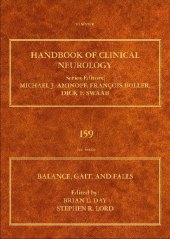 Neuerscheinungen 2018Stand: 2020-02-01 |
Schnellsuche
ISBN/Stichwort/Autor
|
Herderstraße 10
10625 Berlin
Tel.: 030 315 714 16
Fax 030 315 714 14
info@buchspektrum.de |

Brian L. Day, Stephen R. Lord
(Beteiligte)
Balance, Gait, and Falls
Herausgegeben von Day, Brian L.; Lord, Stephen R.
2018. 448 S. 276 mm
Verlag/Jahr: ELSEVIER 2018
ISBN: 0-444-63916-0 (0444639160)
Neue ISBN: 978-0-444-63916-5 (9780444639165)
Preis und Lieferzeit: Bitte klicken
Balance, Gait, and Falls, Volume 159 presents the latest information on sensorimotor anatomy, sensory integration, gravity and verticality, standing balance, balance perturbations, voluntary stepping and gait initiation, gait and gait adaptability, disorders of balance and gait that result from aging and neurological diseases. The book provides a brief overview of age-related changes in the structure and function of sensorimotor and central processes, with sections specifically devoted to Parkinsonīs disease, parkinsonism, cerebellar ataxia, stroke, corticobasal degeneration, multiple sclerosis, Huntingtonīs disease, dystonia, tremor, Alzheimerīs disease, frontotemporal dementia, cerebral palsy, polio, motor neuron disease, brainstem lesions, spinal lesions, peripheral nerve disease, and psychogenic conditions.
Diseases covered have a common structure comprising background and epidemiology, pathology, balance disorders, gait disorders, falls, therapies (including fall prevention), and future directions.
Covers all aspects of basic and clinical research on disorders of balance and gait in neurological disease
Presents a multidisciplinary review of balance and gait physiology, the epidemiology and natural history of balance and gait impairments in aging, and a broad range of neurological diseases
Addresses impairments of balance and gait for basic and clinical researchers in neuroscience, human movement science, physiotherapy and exercise physiology
Section I. Basic Aspects 1. Sensorimotor anatomy of gait, balance and falls 2. Sensory integration for human balance control 3. Gravity estimation and verticality perception 4. Sensorimotor control of standing balance 5. Balance Perturbations 6. Voluntary steps and gait initiation 7. Gait 8. Gait adaptability 9. Ecology of Falls
Section II. Clinical Aspects 10. Ageing 11. Parkinsonīs disease 12. Falls in frontotemporal dementia and related syndromes 13. Stroke 14. Dystonia 15. Balance, gait and falls in multiple sclerosis 16. Gait, balance and falls in Huntington disease 17. Cerebellar ataxia 18. Tremor 19. Dementia 20. Cerebral palsy 21. Poliomyelitis 22. Motor neurone disease 23. Brainstem lesions and gait 24. Balance, gait and falls in spinal cord injury 25. Disorders of the inner ear balance organs and their pathways 26. Peripheral nerve disease 27. Functional (psychogenic) gait disorder: Diagnosis and management
Day, Brian L.
Prof. Dayīs laboratory focuses on neural processes that control human whole-body actions, and the disorders of these processes that result from damage to the central nervous system and from ageing. The actions of interest include standing, walking, rising from a seat, and reaching; the neurological disorders include Parkinsonīs disease, stroke, and cerebellar disease. Of particular interest are the neural processes that combine sensory information from vestibular organs, eyes, muscles and skin to compute the motor instructions necessary for each action, together with the roles played by the cerebellum, basal ganglia, brainstem and cerebral cortex in these computations.
Lord, Stephen R.
Prof. Stephen R. Lord has published over 400 papers in the areas of balance, gait and falls in older people and is acknowledged as a leading international researcher in his field. His research follows two main themes: the identification of physiological risk factors for falls and the development and evaluation of fall prevention strategies. Key aspects of this research have been the elucidation of sensorimotor factors that underpin balance and gait and the design and evaluation of exercise programs for older people including those at increased risk of falls, i.e. people with Parkinsonīs disease, stroke, dementia and frailty. His methodology and approach to fall-risk assessment has been adopted by many researchers and clinicians globally and he is actively engaged in initiatives aimed at implementing falls prevention evidence into policy and practice.


